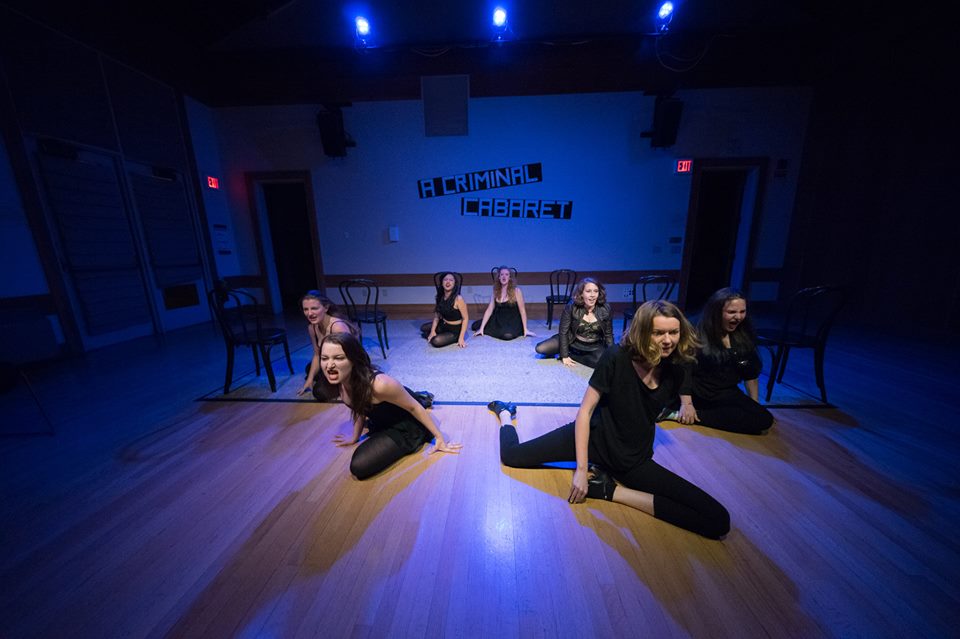
A night full of powerful voices, energetic performances, and dark subject matter, At the Fountain Theatricals’ fall showcase Criminal Cabaret treats us to the exciting stylings of such musical theater greats as Stephen Sondheim and Kander and Ebb, performed as a whirlwind medley in one fell swoop of a production. Focusing on the theme of criminals and channeling some of the darkest characters in Broadway’s history, there’s something special about sitting back and enjoying these beautiful voices belt such incredible pieces.
Lianna Holston, for example, is phenomenal in her rendition of Chicago’s “Roxie,” her mix of sensual and snappy choreography replicating the jazz era murderess almost perfectly; I could see Roxie in her sly smile, in her clear, sweet voice, in her high kicks and swinging legs. Likewise, Abigail Flowers’s performance of “Last Midnight” and “Witch’s Rap” from Into the Woods also demonstrates an exceptional adherence to the musical text the performance was drawn from; Flowers’s languid sarcasm and subtle villainy in her sweeping movements combines with the raw power of her fantastic voice to fully channel the character of the Witch. Flowers is so precise in her diction that you can hear each green she is describing in “Witch’s Rap,” and her belt is so strong and so ground-breaking that it practically shakes the Elliott Program Center to the ground in “Last Midnight,” showcasing a strong repertoire of vocal stylings not many performers hold.
Not all numbers adhere to their musical’s book, however. In Addy Mendoza’s incredibly powerful and moving performance of “No Good Deed” from Wicked, the line “all of Oz can see” is changed to “all of us can see.” In the rendition of Urinetown’s “Don’t Be the Bunny,” the line “you’re much better than that, Hope” is changed to “you’re much better than that, I hope.” Yet Sweeney Todd and Mrs. Lovett are still Sweeney Todd and Mrs. Lovett in “A Little Priest,” and the performance of Urinetown’s “Snuff that Girl” still includes the line “here’s an acorn from Cladwell I see” (despite Hope being replaced by the Witch as a hostage). The creative freedom At the Fountain Theatricals takes in this cabaret is by all means allowed; in fact, the use of marijuana joints in “Razzle Dazzle” is absolutely hysterical, and some of the transitions between songs (most notably “Dog Eat Dog,” “Snuff that Girl,” and “Last Midnight”) are quite smooth as one linear narrative. As a whole production, however, it comes off as disjointed and somewhat cacophonous. Elphaba needs to exist if the Cook County Murderesses and Roxie Hart exist. Caldwell B. Cladwell needs to disappear if Hope Cladwell is not in the picture. Picking and choosing songs to change and songs to not change confused me, as a self-proclaimed musical aficionado who has seen all of the shows these songs were pulled from. Criminal Cabaret lacks coherency, coming off more as a hodgepodge of musical numbers rather than one connected concert centering around a common theme.
As an ensemble, however, the company thrives. In the performance of “Murder, Murder” from Jekyll and Hyde, the ensemble bounces off of each other in impeccable comedic timing. The uniformity of the choreography brings a mixture of fun intensity to the piece, and the expressiveness of the actors bolsters it to new heights. In the rendition of Chicago’s “Cell Block Tango,” the movements of the female ensemble are smooth, sultry, intense, and angry, beautifully capturing the rage and character of the Cook County Murderesses.
Despite its flaws, Criminal Cabaret is a fun, awesome, and entertaining night of musical theater. At the Fountain Theatricals holds some of the greatest talent at Stanford, and this show could definitely get away with murder.
